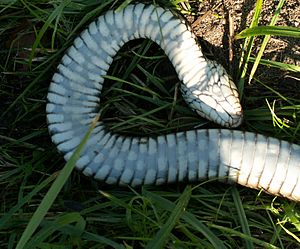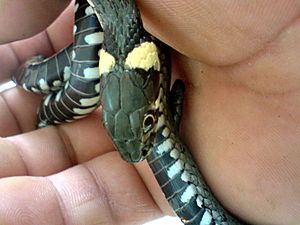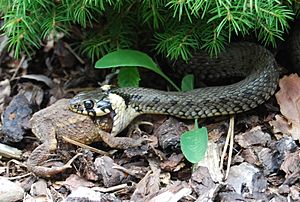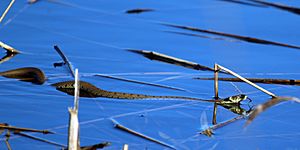Grass snake facts for kids
Quick facts for kids Grass snake |
|
|---|---|
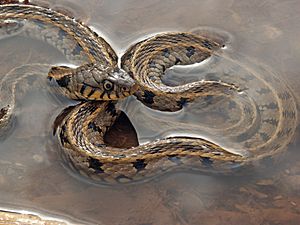 |
|
| Conservation status | |
| Scientific classification | |
| Kingdom: | |
| Subphylum: | |
| Class: | |
| Order: | |
| Suborder: | |
| Family: | |
| Genus: |
Natrix
|
| Binomial name | |
| Natrix natrix |
|
The grass snake (Natrix natrix) is a type of snake that is not venomous. You can often find them near water. They mostly eat amphibians like frogs and toads.
These snakes live in many parts of Europe, from Scandinavia in the north to Italy in the south. They are also found in the Middle East and parts of northwestern Africa.
In Great Britain, the grass snake was once thought to be one of only three types of snakes living there. However, scientists now believe that the grass snakes in Great Britain are a different species called the barred grass snake. The grass snake is found in lowland areas of England and Wales. You won't find them in Scotland or Ireland, as Ireland has no native snakes at all.
Contents
What Does a Grass Snake Look Like?
Grass snakes are usually dark green or brown. They have a special yellow ring or "collar" right behind their head. This is why they are sometimes called "ringed snakes." Their color can also be grey or even black. Snakes in colder places are often darker. This helps them soak up more heat from the sun.
The underside of a grass snake is whitish with black spots that are not in a regular pattern. These unique spots can help tell one snake from another. In Great Britain, the grass snake is the biggest reptile. Female grass snakes can grow up to about 80 centimeters (31 inches) long. Males are usually a bit smaller, around 60 centimeters (24 inches) long. A grass snake typically weighs about 240 grams (8.5 ounces).
Where Do Grass Snakes Live?
Grass snakes are found across a large area of mainland Europe. This includes places from central Scandinavia down to southern Italy. They also live in the Middle East and northwestern Africa.
For a long time, scientists thought the grass snakes in Great Britain were a subspecies called N. n. helvetica. However, it is now known that these snakes are actually a separate species, the barred grass snake (Natrix helvetica). Any grass snakes found in Britain today are thought to have come from other countries.
How Grass Snakes Live Their Lives
What Do Grass Snakes Eat?
Grass snakes mostly eat amphibians. Their favorite meals are the common toad and the common frog. Sometimes, they might also eat ants or insect larvae. If you offer a captive grass snake an earthworm by hand, it might take it. However, they will never eat prey that is already dead.
These snakes actively look for food, often near the edges of water. They use both their eyesight and their sense of smell to find prey. Their sense of smell is helped by a special organ called the Jacobson's organ. Grass snakes eat their prey alive. They do not squeeze their prey like some other snakes do.
Where Do Grass Snakes Find a Home?
Grass snakes are very good swimmers. You can often find them near fresh water. However, some individual snakes don't need to be near water all the time.
They seem to prefer open woodlands and areas where forests meet fields. These "edge" habitats offer good places to hide. They also give the snakes plenty of chances to warm up in the sun. Pond edges are also popular. Because it's easier to spot these shy snakes near ponds, people often think they always live in water.
Like most reptiles, grass snakes need warm places. They spend the winter underground where it's warm enough not to freeze. This helps them survive the cold months.
Reproduction and Life Cycle
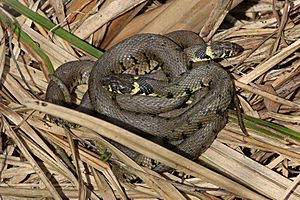
When spring arrives, the male snakes come out first. They spend a lot of time basking in the sun. This helps them warm up their bodies and get ready for mating. They mate with the females about two weeks later in April. This can happen even earlier if the weather is warm enough.
Female grass snakes lay their eggs in batches of 8 to 40 eggs. This usually happens in June or July. The eggs have a leathery skin and hatch after about 10 weeks. For the eggs to hatch, they need to be warm, at least 21°C (70°F), but ideally around 28°C (82°F), with lots of moisture. They often choose piles of rotting vegetation, like compost heaps, to lay their eggs. When the young snakes hatch, they are about 18 centimeters (7 inches) long and can take care of themselves right away.
How Grass Snakes Move Around
After breeding in the summer, grass snakes tend to hunt. They can travel quite far during this time, sometimes moving hundreds of meters in a single day. The food they eat can be very big compared to their own size. This makes it hard for them to move.
Snakes that have just eaten usually don't move much. They will stay in one spot and bask in the sun. This helps them digest their meal. A single snake might only need to eat two or three big meals during an entire season.
Shedding Their Skin (Moulting)
Shedding skin happens at least once during the active season. As the snake grows and its outer skin wears out, a new skin forms underneath. During this time, the scales over their eyes can turn a milky blue-white color. This is called being "in blue." The blue color comes from an oily liquid between the old and new skin. The snake's colors will also look dull, almost dusty.
When a snake is "in blue," its eyesight is not as good. They usually don't move or hunt during this time. Like most other snakes, they can also be more aggressive. Eventually, the old skin peels off in one piece, turning inside-out. After this, the snake goes back to its normal activities.
How Grass Snakes Protect Themselves
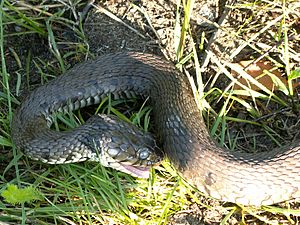
Since grass snakes are not venomous, they have other ways to defend themselves. One way is to release a fluid from glands near their tail that smells like garlic. Another common defense is to pretend to be dead. This is called thanatosis. The snake will go completely limp.
They might also put on an aggressive show. They will hiss and strike without opening their mouth. But they rarely bite when defending themselves. Sometimes, when playing dead, they might even secrete blood from their mouth and nose. If they are caught, they often throw up the food they have eaten.
Protection and Threats to Grass Snakes
Grass snakes have several animals that prey on them. These include crows, storks, owls, and other birds of prey. Foxes and domestic cats also hunt them. In England, grass snakes are protected by a law called the Wildlife and Countryside Act 1981. This means it's against the law to harm them or sell them without a special permit. However, it is legal to catch and keep them in captivity.
Images for kids
-
An old drawing showing Lithuanians worshipping a grass snake (žaltys) and holy fire. From Olaus Magnus' book Historia de Gentibus Septentrionalibus (History of the Northern People), 1555.
-
A grass snake hunting in early autumn in Sweden.
See also
 In Spanish: Culebra de collar para niños
In Spanish: Culebra de collar para niños



